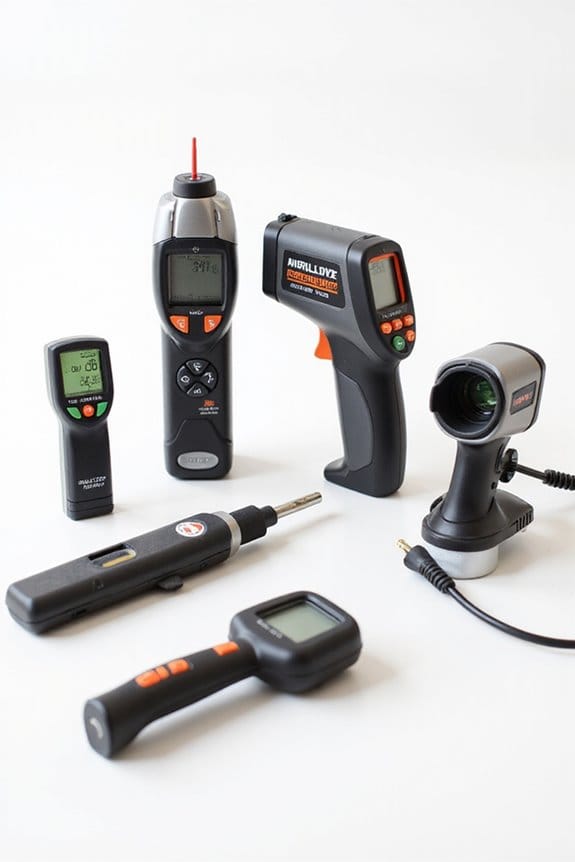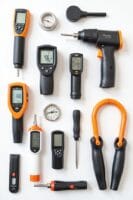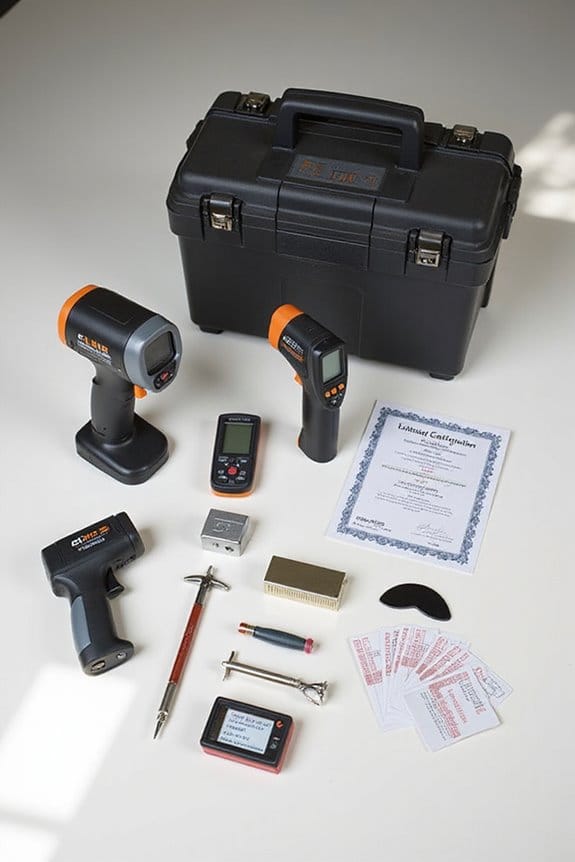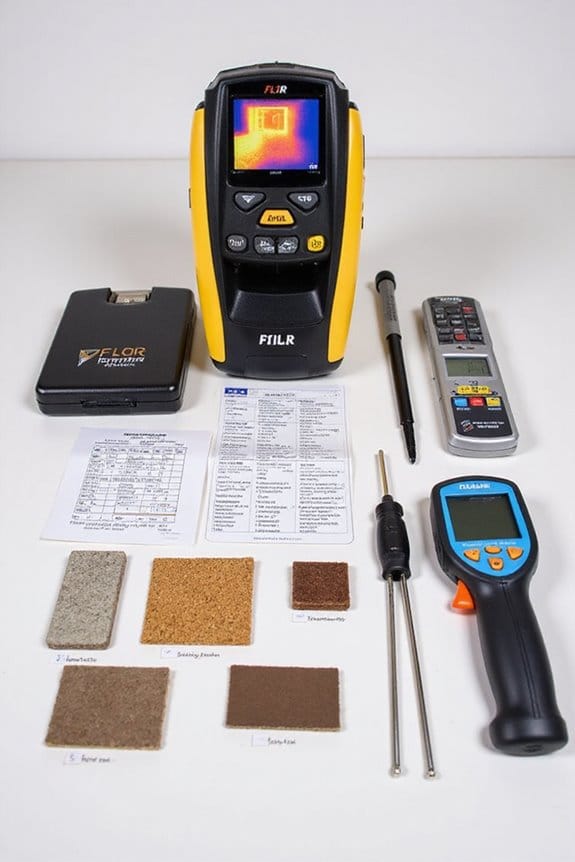Infrared thermometers work by detecting infrared radiation emitted from an object. Here’s how it goes: 1) They focus this IR radiation onto a thermopile. 2) The thermopile converts that energy into heat, generating voltage. 3) A microprocessor then turns that voltage into a temperature reading. It’s quick and doesn’t require contact—perfect for hot or hazardous surfaces! Just keep in mind that they measure surface temperatures, so don’t expect to check that turkey’s core without a probe! Want to learn more about their ins and outs?
Key Takeaways
- Infrared thermometers detect infrared radiation emitted from objects and convert it into electrical voltage through a thermopile.
- Lenses focus the infrared radiation onto the thermopile for accurate temperature measurement.
- The microprocessor processes the voltage signal from the thermopile to display the corresponding temperature reading.
- They provide instant, non-contact temperature measurements, making them ideal for various surfaces.
- Accuracy can be affected by surface contamination, ambient conditions, and incorrect emissivity settings.
Principle of Operation

When we think about how infrared thermometers work, it’s pretty fascinating to realize they rely on some clever science. Here’s a quick rundown of the principle of operation:
- Lens Focusing: The thermometer uses a lens system to focus infrared radiation from an object. This lens acts like those used for visible light, directing and concentrating IR rays for better accuracy.
- Thermopile Function: The focused IR radiation hits a thermopile, which consists of thermocouples. This device absorbs the infrared energy, converting it into heat.
- Voltage Output: As a result, the thermopile generates a voltage that correlates with the object’s temperature.
Understanding Infrared Radiation
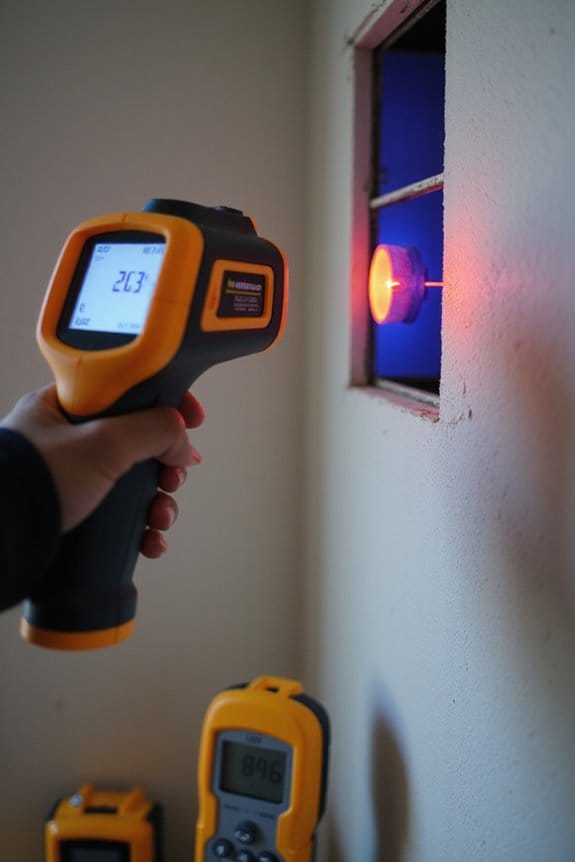
Infrared radiation, often abbreviated as IR, plays an essential role in our understanding of heat transfer and energy. It’s fascinating how these infrared waves, with wavelengths longer than visible light, allow us to sense heat from a distance. Here are a few key points about IR:
- Electromagnetic Waves: IR is part of the electromagnetic spectrum, sitting between visible light and microwaves.
- Heat Transfer: It’s a primary method of heat transfer, often called radiant heat.
- Thermal Imaging: We can use thermal imaging to visualize IR radiation, revealing temperature differences in objects. The effectiveness of infrared thermometers is enhanced by thermal imaging cameras, which provide detailed visualizations of temperature variations.
This ability to detect IR is why infrared thermometers are so effective. They give us a peek into the invisible world of heat, making our lives a bit easier—and cooler!
Key Components of Infrared Thermometers
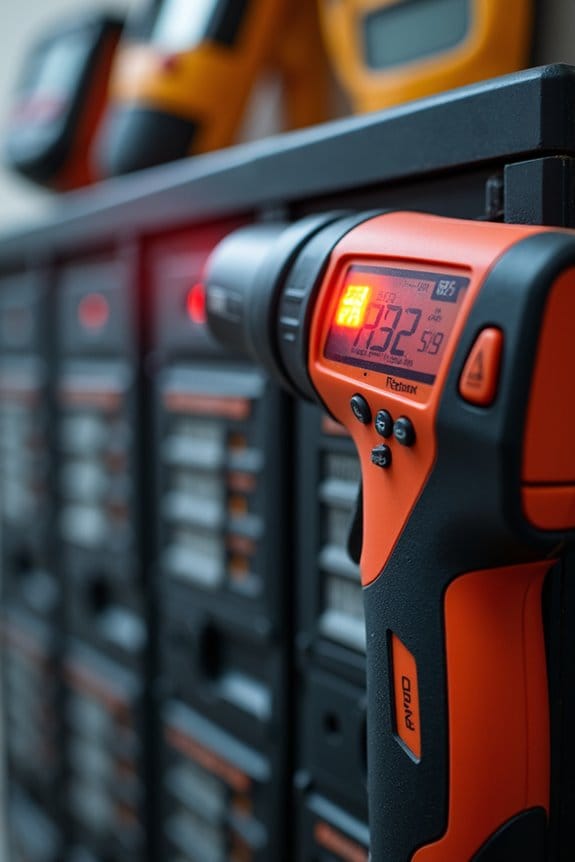
One of the fascinating aspects of infrared thermometers is their key components, each playing an essential role in measuring temperature accurately. Here are the essentials:
- Optical Components: These include lenses that focus the infrared radiation from the target onto the detector. The quality of these lenses affects the distance-to-spot ratio, which is important for accuracy.
- Detector Types: The main types are thermopiles and pyroelectric detectors. Thermopiles are widely used, converting absorbed infrared radiation into heat and then electrical voltage.
- Microprocessor: This processes the signal from the detector, converting it into a temperature reading. It also compensates for factors like ambient temperature.
Each component works together, making IR thermometers reliable tools for quick and accurate readings.
Advantages of Using Infrared Thermometers
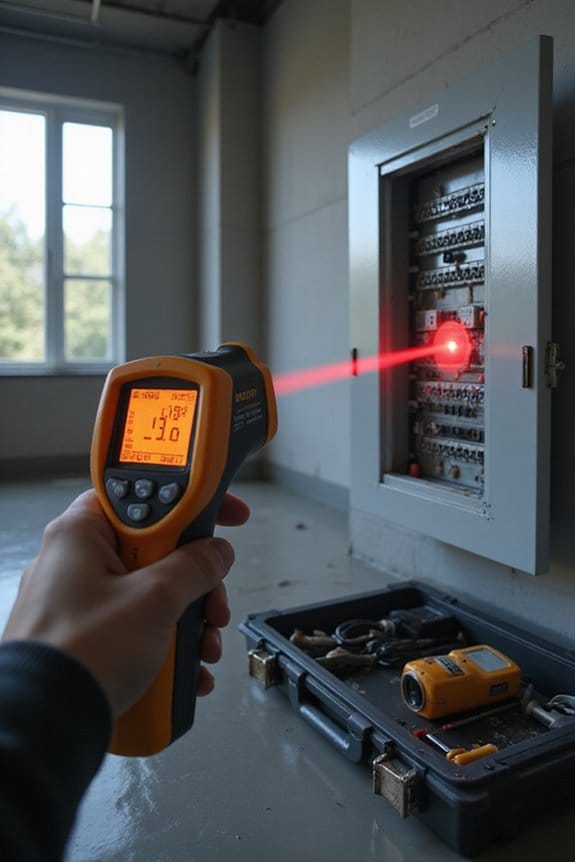
With all that talk about the key components of infrared thermometers, it’s time to explore why they’re such handy tools. Here are a few advantages that stand out:
- User Convenience: These devices give you instant temperature readings, making it super quick to check multiple people or objects without waiting around.
- Hygiene Benefits: With non-contact measurement, you’re reducing the risk of contamination—perfect for medical settings or food safety.
- Versatility: They work on hot, hazardous, or hard-to-reach surfaces, so you can avoid dangerous situations.
- Easy to Use: Just point and shoot! Plus, they’re simple to clean since there’s no direct contact.
In short, infrared thermometers make temperature checking easier, safer, and more efficient. Who wouldn’t want that?
Limitations and Considerations
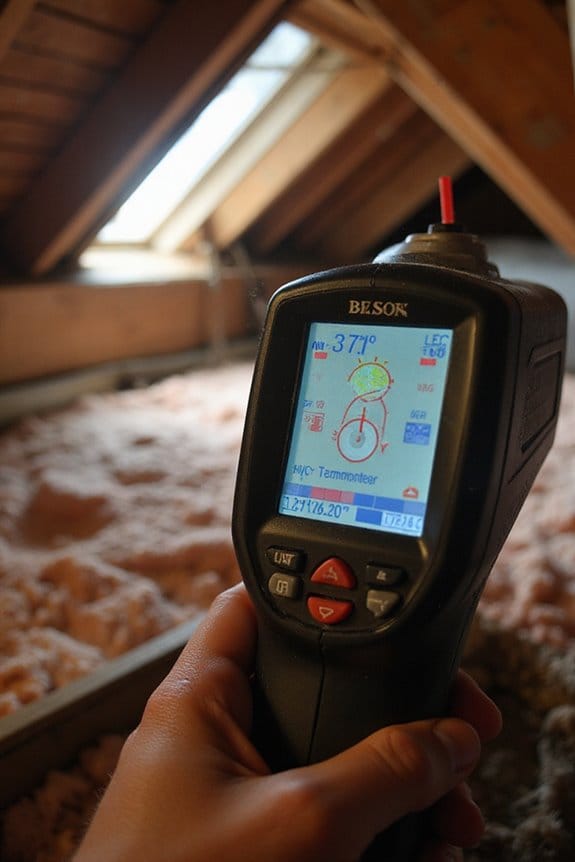
While these handy devices are fantastic for quick temperature checks, it’s important to keep in mind their limitations and considerations. Here’s what I think you should know:
- Measurement Accuracy: They only read surface temperatures, not the core temperature of items.
- Surface Contamination: Issues like dust or frost can mess up readings.
- Ambient Interference: Factors like fog or smoke can disrupt the accuracy.
- Emissivity Settings: If the emissivity isn’t set right for the material, you’ll get incorrect readings.
Surface Emissivity and Its Impact
How does surface emissivity really affect the accuracy of infrared thermometers? Well, it’s essential! Emissivity variation means different materials emit infrared radiation differently. If I set an infrared thermometer incorrectly, I might get temperature readings that are way off. Here’s why:
- Misestimation: Setting the emissivity too high can lead to underestimating the temperature.
- Emissivity Correction: This adjustment compensates for a surface’s ability to emit radiation, ensuring more precise readings.
For example, shiny metals have low emissivity, while organic materials often have high values. So, knowing the material’s emissivity helps in getting accurate measurements. When in doubt, consider using a contact sensor to adjust the emissivity setting—your thermometer will thank you!
Environmental Factors Affecting Measurements
When you’re using an infrared thermometer, you might not realize how much environmental factors can play a role in the accuracy of your readings. Here are some key points to take into account:
- Ambient Temperature: If the background temperature is close to your target, your readings can be skewed.
- Relative Humidity: High humidity can absorb infrared signals, affecting accuracy. It’s like trying to see through fog!
- Measurement Distance: The farther away you are from your target, the more atmospheric interference can distort your readings.
- Environmental Interference: Dust or smoke can scatter infrared radiation, making it tricky to get reliable data.
- Thermal Equilibrium and Sensor Warm-up: Always let your thermometer reach thermal equilibrium for stable measurements. A little patience goes a long way!
Applications in Various Industries
Infrared thermometers are like the unsung heroes of various industries, quietly ensuring everything runs smoothly. Here are some key industrial applications I find fascinating:
- Industrial Equipment Monitoring: They help detect overheating in boilers and pipes, preventing costly downtime.
- Electrical Systems: By measuring temperatures in panels and transformers, they identify hotspots that could lead to fires.
- HVAC: These devices check air conditioning units without requiring shutdowns, enhancing energy efficiency.
- Firefighting: They locate hotspots in hazardous environments, keeping firefighters safe while they strategize.
- Manufacturing: Infrared thermometers monitor machinery temperatures, ensuring quality control and reducing waste.
In each case, they play a crucial role in safety inspections and operational efficiency. Who knew a little device could do so much?
Best Practices for Accurate Measurements
Getting accurate measurements with an infrared thermometer is essential for reliable results. Here are some best practices I recommend:
- Know Your D:S Ratio: Keep the measurement area smaller than the target spot. For instance, a 12:1 ratio means measure 1 inch from 12 inches away.
- Surface Prep: Avoid reflective surfaces and stir liquids for uniform temperature.
- Stay Still: Movement can blur readings, so keep steady.
- Calibration Importance: Regularly check your thermometer’s calibration—consult the manual for intervals.
- Clean Regularly: Wipe the lens to prevent debris from skewing results.
Following these measurement techniques can vastly improve accuracy. Trust me, a little attention to detail goes a long way!
Frequently Asked Questions
Can Infrared Thermometers Measure Temperature Through Glass or Plastic?
Like a painter’s brush unable to capture colors through a canvas, infrared thermometers can’t measure temperatures through glass. Thin plastic types can work, but glass thickness often distorts the true temperature beneath.
How Do I Choose the Right Infrared Thermometer for My Needs?
When I choose an infrared thermometer, I compare features based on my usage scenarios. Understanding temperature ranges, D:S ratios, and response times helps guarantee I get the right tool for my specific needs.
What Is the Typical Lifespan of an Infrared Thermometer?
Did you know that a forehead infrared thermometer typically lasts around two years? The infrared thermometer lifespan varies considerably based on factors affecting durability, like usage frequency and environmental conditions. Treat it well, and it’ll last longer!
Are Infrared Thermometers Safe to Use on Humans?
I’ve found that infrared thermometers are generally safe for human applications. While some safety concerns exist, proper use and hygiene practices minimize risks, ensuring they’re effective and reliable tools for measuring temperatures without harmful effects.
How Often Should I Calibrate My Infrared Thermometer?
You might be wondering about the perfect calibration frequency for your infrared thermometer. I’d suggest annual checks for temperature accuracy, but if you’re using it intensively or in critical situations, more frequent calibrations are essential.

